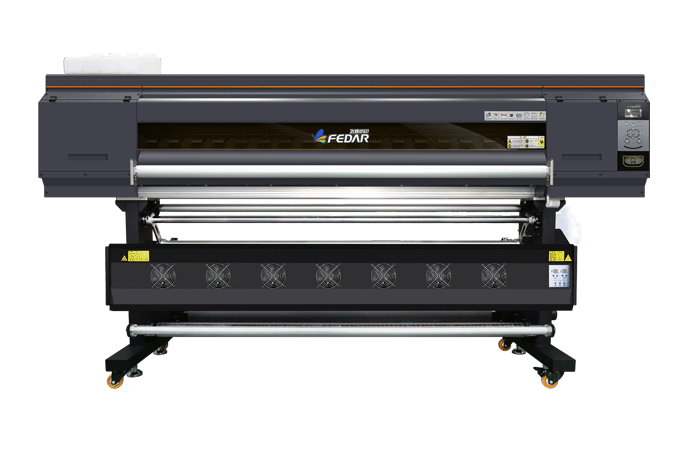Fedar heat transfer digital printing machine and Fedar direct-injection digital printing machine have been widely used in the fields of digital printing, textile, advertising, home furnishing and personalized design. The products have passed ISO9001 quality system certification and CE certification, and have won the majority of consumers. trust. Through cooperation with world-renowned printhead manufacturers and software suppliers, the latest and most practical technology is integrated into the product, and it has the world's leading clothing plate making system, digital printing system, textile printing and dyeing system, advertising inkjet system, and the overall printing and dyeing industry solution.

The so-called digital reactive ink is actually a liquid reactive dye. It is a kind of ink widely used in digital printing applications. It has the advantages of wide variety of fabrics, good color fastness, and convenient use. It can be applied to cellulose. Fiber, protein fiber and other fabrics. Its main ingredients are: dyes, deionized water, PH buffers, bactericide surfactants. Surfactants have two functions. One is to control the surface tension of the ink to adapt it to the requirements of the digital printing machine.
Currently widely used piezoelectric printheads have high requirements for viscosity and surface tension. If the viscosity is too high, it will easily block the printheads. If the viscosity is too low, it will easily cause ink rejection and form secondary cloth. Generally, the viscosity is required to be controlled at 10-50mPa.s. The surface tension should be controlled within 30-60 dyne/cm, so as to ensure that the dye can penetrate into the fiber smoothly, but also to maintain the fineness of the pattern; in addition, the surfactant can help the dye to improve the liquid dye. Strength. Surfactants generally use glycols or naphthalenesulfonic acids. For example, CIBAMI series inks are homologues of propylene glycol and sodium naphthalenesulfonate. The function of the bactericide is to prevent mold in the ink channel of the digital printing machine from clogging the ink channel. In the early days of digital printing, a similar situation occurred in Europe. In order to ensure the stability of the dye solution, the PH value should be controlled at about 8. In liquid dyes, it is also very important to control the content of inorganic salts, so deionized water must be used during the preparation of the dye solution, and other additives must also be removed by nanofiltration industry to remove inorganic salts. The content of inorganic salt can be detected by detecting its conductivity, and the control value should be less than 2000uΩ/cm.
For insoluble disperse dyes, when the concentration of inorganic salt increases, more charges that are electrically negative with the adsorption layer will enter the adsorption layer. When the charge of the adsorption layer is completely neutralized, the zeta potential in the micelle drops to zero, which makes the electrostatic repulsion of the micelle smaller or even disappears completely, greatly reducing the anti-cohesion ability of the dispersion, and making the entire dispersion system stable The sex is destroyed, causing the dye to settle. In addition, the high concentration of inorganic salt can easily corrode the printhead and reduce the service life of the printhead. At present, the common digital active inks in the domestic market have several colors such as cyan, black, magenta, blue, orange, yellow, and gray. In addition, cyan and magenta are diluted to about 15-20% to make light cyan and light red. It can meet the basic production needs, but there are still problems in applications such as clogged printheads, unstable color development, incorrect color light, insufficient depth, and small color gamut. The reasons for the clogging of the printheads are digital printing machines and dyes. The main reasons for the machine are the interruption of ink supply, the clogging of the ink channel, and the air outlet of the ink cartridge. The main reasons for dyes are dye deposition, impurities, and excessive dye solubility. For insoluble disperse dyes, the particle size of the dye is also very important, and the particle size requires no more than 10 particles above 0.2 microns in the field of view of the microscope 0.1mm.
The clogged printheads are mainly black, blue, magenta, and cyan colors, among which black is the most powerful, especially when printing a large amount of background color. This is not only related to its dye matrix structure, but also to its concentration.
We found that after diluting the black ink that often clogs printheads by 20% or more with diluent, the phenomenon of printhead clogging is greatly improved. However, the current black ink itself has the problem of insufficient strength and low color depth. Therefore, reducing the solubility of the dye to improve the clogging phenomenon also has certain drawbacks. If the ink is left for more than 3-6 months, it is easy to cause printhead clogging. Before use, use Buchner funnel to filter with two layers of filter paper. In addition, some inks may have agglomeration. Once the ink channel leaks slightly, it will cause a large area of printhead blockage. To know whether the ink will cause agglomeration, you can drop a drop of ink on the film paper and place it in the air to make it volatilize naturally. Look at the residue. If it is in the shape of a flake, it will cause agglomeration. will not. The unstable color development mainly includes two colors of cyan and gray. The reason for the unstable color development of cyan is because the dye matrix is copper phthalocyanine, and the dye molecules are too large to cause poor permeability, which is sensitive to humidity and causes color instability. The reason that the gray color is unstable is that the dye manufacturer uses three or two colors to compound the gray color, which is caused by the compatibility or the sensitivity of the single color.

Therefore, controlling the evaporation conditions is the key to controlling the color light. It is recommended to use continuous steaming equipment and steaming together with the bulk to ensure stable steaming conditions. Cyan dyes are steamed under higher humidity conditions, and the hair color is strong, while steaming under lower humidity conditions tends to fade in color. Therefore, pay attention to the amount of urea when sizing. If the amount of urea is too high, the cloth surface is too wet, the pattern is oozing, and it is easy to make the cloth surface yellow, which affects the vividness of the color, and if it is too low, it affects the vaporization humidity and cyan hair. The color is too light. Another important factor that affects the stability of hair color is the steaming equipment. The static steaming equipment is stationary because the cloth is still inside, and the airflow inside the steaming box cannot effectively circulate, so it will inevitably cause the steaming everywhere in the cloth. There are differences in the environment, resulting in color difference.
Therefore, it is recommended to use continuous steaming equipment and steaming together with the bulk to ensure stable steaming conditions. The so-called small color gamut means that the color range mixed by the three primary colors of digital ink is smaller than the color range mixed by theory or printing.
Zhengzhou New Century Digital Technology Co., Ltd.,- (Fedar Printer:
www.fedar.net) has exquisite production technology and professional technical team in the field of fedar sublimation printers,inkjet heat transfer printer,digital fabric printer,etc., focusing on providing comprehensive solution for field of inkjet printing.
Fedar sublimation printer company has absorbed and condensed a group of high-quality professional technicians and enterprising young management groups, formed a strong technical team and increasingly rigorous management system,providing customers with high-quality printing machines and services,and has established a good brand image and reputation in industry.




